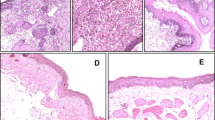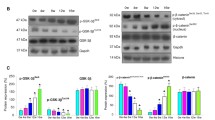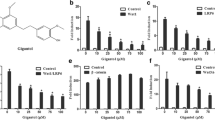Abstract
Purpose
Constitutive activation of the Wnt signaling pathway and its downstream effectors plays a key role in neoplastic transformation. The objective of this study was to investigate the effect of ellagic acid, a plant-derived polyphenol on Wnt/β-catenin signaling and its downstream circuits- NF-κB and mitochondrial apoptosis in the 7,12-dimethylbenz[a]anthracene (DMBA)-induced hamster buccal pouch (HBP) carcinogenesis model.
Methods
Hamsters were divided into six groups. The right buccal pouches of animals in groups 1–4 were painted with 0.5% DMBA three times a week for 14 weeks. Animals in groups 2–4 received in addition basal diet containing ellagic acid at a concentration of 0.1, 0.2, and 0.4% in the diet. Group 5 animals were given 0.4% ellagic acid alone. Group 6 animals served as control. The expression of the members of Wnt and NF-κB signaling and intrinsic apoptosis was evaluated by western blot analysis.
Results
Dietary supplementation of 0.4% ellagic acid suppressed the development of HBP carcinomas by preventing the constitutive activation of Wnt pathway through the downregulation of Fz, Dvl-2, GSK-3β and nuclear translocation of β-catenin. Abrogation of Wnt signaling by ellagic acid was also associated with inactivation of NF-κB and modulation of key components of the mitochondrial apoptotic network.
Conclusions
Our findings suggest a functional crosstalk between Wnt and NF-κB signaling pathways in HBP carcinomas that is blocked by ellagic acid supplementation. Dietary ellagic acid that targets the Wnt/β-catenin pathway as well as its downstream signaling mediators is a unique candidate for cancer chemoprevention.





Similar content being viewed by others
References
Sethi JK, Vidal-Puig A (2010) Wnt signalling and the control of cellular metabolism. Biochem J 427:1–17
Queimado L, Obeso D, Hatfield MD, Yang Y, Thompson DM, Reis AM (2008) Dysregulation of Wnt pathway components in human salivary gland tumors. Arch Otolaryngol Head Neck Surg 134:94–101
Fu L, Zhang C, Zhang LY, Dong SS, Lu LH, Chen J, Dai Y, Li Y, Kong KL, Kwong DL, Guan XY (2011) Wnt2 secreted by tumour fibroblasts promotes tumour progression in oesophageal cancer by activation of the Wnt/{beta}-catenin signalling pathway. Gut 60:1635–1643
Nojima M, Suzuki H, Toyota M, Watanabe Y, Maruyama R, Sasaki S, Sasaki Y, Mita H, Nishikawa N, Yamaguchi K, Hirata K, Itoh F et al (2007) Frequent epigenetic inactivation of SFRP genes and constitutive activation of Wnt signaling in gastric cancer. Oncogene 26:4699–4713
Nusse R (2005) Wnt signaling in disease and in development. Cell Res 15:28–32
Ma Y, Wang M, Li N, Wu R, Wang X (2009) Bleomycin-induced nuclear factor-kappaB activation in human bronchial epithelial cells involves the phosphorylation of glycogen synthase kinase 3beta. Toxicol Lett 187:194–200
Sanchez JF, Sniderhan LF, Williamson AL, Fan S, Chakraborty-Sett S, Maggirwar SB (2003) Glycogen synthase kinase 3beta-mediated apoptosis of primary cortical astrocytes involves inhibition of nuclear factor kappaB signaling. Mol Cell Biol 23:4649–4662
Chaturvedi MM, Sung B, Yadav VR, Kannappan R, Aggarwal BB (2011) NF-kB addiction and its role in cancer: ‘one size does not fit all’. Oncogene 30:1615–1630
Sung B, Pandey MK, Ahn KS, Yi T, Chaturvedi MM, Liu M, Aggarwal BB (2008) Anacardic acid (6-nonadecyl salicylic acid), an inhibitor of histone acetyltransferase, suppresses expression of nuclear factor-kappaB-regulated gene products involved in cell survival, proliferation, invasion, and inflammation through inhibition of the inhibitory subunit of nuclear factor-kappaBalpha kinase, leading to potentiation of apoptosis. Blood 111:4880–4891
Pećina-Slaus N (2010) Wnt signal transduction pathway and apoptosis: a review. Cancer Cell Int 10:22
Leibowitz B, Yu J (2010) Mitochondrial signaling in cell death via the Bcl-2 family. Cancer Biol Ther 9:417–422
Altieri DC (2010) Survivin and IAP proteins in cell-death mechanisms. Biochem J 430:199–205
Heiser D, Labi V, Erlacher M, Villunger A (2004) The Bcl-2 protein family and its role in the development of neoplastic disease. Exp Gerontol 39:1125–1135
Adrain C, Creagh EM, Martin SJ (2001) Apoptosis-associated release of Smac/DIABLO from mitochondria requires active caspases and is blocked by Bcl-2. EMBO J 20:6627–6636
Frezza C, Cipolat S, De Brito OM, Micaroni M, Beznoussenko VG, Rudka T, Bartoli D, Polishuck RS, Danial NN, Strooper BD, Scorrano L (2006) OPA1 controls apoptotic cristae remodeling independently from mitochondrial fusion. Cell 126:177–189
Kundu JK, Surh YJ (2005) Breaking the relay in deregulated cellular signal transduction as a rationale for chemoprevention with anti-inflammatory phytochemicals. Mutat Res 591:123–146
Festa F, Aglitti T, Duranti G, Ricordy R, Perticone P, Cozzi R (2001) Strong antioxidant activity of ellagic acid in mammalian cells in vitro revealed by the comet assay. Anticancer Res 21:3903–3908
Seeram NP, Adams LS, Henning SM, Niu Y, Zhang Y, Nair MG, Heber D (2005) In vitro antiproliferative, apoptotic and antioxidant activities of punicalagin, ellagic acid and a total pomegranate tannin extract are enhanced in combination with other polyphenols as found in pomegranate juice. J Nutr Biochem 16:360–367
Rao CV, Tokumo K, Rigotty J, Zang E, Kelloff G, Reddy BS (1991) Chemoprevention of colon carcinogenesis by dietary administration of piroxicam, α-difluoromethylornithine, 16α-fluoro-5-androsten-17-one, and ellagic acid individually and in combination. Cancer Res 51:4528–4534
Loarca-Pina G, Kuzmicky PA, de Mejia EG, Kado NY (1998) Inhibitory effects of ellagic acid on the direct-acting mutagenicity of aflatoxin B1 in the Salmonella microsuspension assay. Mutat Res 398:183–187
Shklar G (1999) Development of experimental oral carcinogenesis and its impact on current oral cancer research. J Dent Res 78:1768–1772
Vidya Priyadarsini R, Vinothini G, Senthil Murugan R, Manikandan P, Nagini S (2011) The flavonoid quercetin modulates the hallmark capabilities of hamster buccal pouch tumours. Nutr Cancer 63:218–226
Singletary K, Liao CH (1989) Ellagic acid effects on the carcinogenicity, DNA-binding and metabolism of 7, 12-dimethylbenz(a)anthracene (DMBA). In Vivo 3:173–175
Legrand-Poels S, Schoonbrodt S, Piette J (2000) Regulation of interleukin-6 gene expression by pro-inflammatory cytokines in a colon cancer cell line. Biochem J 349:765–773
Chan SH, Wu CA, Wu KL, Ho YH, Chang AY, Chan JY (2009) Transcriptional upregulation of mitochondrial uncoupling protein 2 protects against oxidative stress-associated neurogenic hypertension. Circ Res 105:886–896
Bradford MM (1976) A rapid and sensitive method for the quantitation of microgram quantities of protein-dye binding. Anal Biochem 72:248–254
Laemmli UK (1970) Cleavage of structural proteins during the assembly of the head of bacteriophage T4. Nature 227:680–685
Chen SC, Chung KT (2000) Mutagenicity and antimutagenicity studies of tannic acid and its related compounds. Food Chem Toxicol 38:1–5
Umesalma S, Sudhandiran G (2010) Differential inhibitory effects of the polyphenol ellagic acid on inflammatory mediators NF-kappaB, iNOS, COX-2, TNF-alpha, and IL-6 in 1, 2-dimethylhydrazine-induced rat colon carcinogenesis. Basic Clin Pharmacol Toxicol 107:650–655
Tanaka T, Kojima T, Kawamori T, Wang A, Suzui M, Okamoto K, Mori H (1993) Inhibition of 4-nitroquinoline-1-oxide-induced rat tongue carcinogenesis by the naturally occurring plant phenolics caffeic, ellagic, chlorogenic and ferulic acids. Carcinogenesis 14:1321–1325
Lesca P (1983) Protective effects of ellagic acid and other plant phenols on benzo[a]pyrene-induced neoplasia in mice. Carcinogenesis 4:1651–1653
Harttig U, Hendricks JD, Stoner GD, Bailey GS (1996) Organ specific, protocol dependent modulation of 7, 12-dimethylbenz[a]anthracene carcinogenesis in rainbow trout (Oncorhynchus mykiss) by dietary ellagic acid. Carcinogenesis 17:2403–2409
Na L, Jun-tian L, Qiang-zong Z (2010) Ellagic acid-induced hypercoagulable state in animals: a potentially useful animal hypercoagulable model for evaluation of anticoagulants. Chin Med Sci 25:237–242
Hara T, Iwamoto M, Ishihara M, Tomikawa M (1994) Preventive effect of argatroban on ellagic acid-induced cerebral thromboembolism in rats. Haemostasis 24:351–357
Mandal S, Stoner GD (1990) Inhibition of N-nitrosobenzylmethylamine-induced esophageal tumorigenesis in rats by ellagic acid. Carcinogenesis 11:55–61
Tasaki M, Umemura T, Maeda M, Ishii Y, Okamura T, Inoue T, Kuroiwa Y, Hirose M, Nishikawa A (2008) Safety assessment of ellagic acid, a food additive, in a subchronic toxicity study using F344 rats. Food Chem Toxicol 46:1119–1124
Serra R, Easter SL, Jiang W, Baxley SE (2011) Wnt5a as an effector of TGFβ in mammary development and cancer. J Mammary Gland Biol Neoplasia 16:157–167
Uraguchi M, Morikawa M, Shirakawa M, Sanada K, Imai K (2004) Activation of WNT family expression and signaling in squamous cell carcinomas of the oral cavity. J Dent Res 83:327–332
Barbolina MV, Burkhalter RJ, Stack MS (2011) Diverse mechanisms for activation of Wnt signalling in the ovarian tumour microenvironment. Biochem J 437:1–12
Najdi R, Holcombe RF, Waterman ML (2011) Wnt signaling and colon carcinogenesis: beyond APC. J Carcinog 10:5
Gaston-Massuet C, Andoniadou CL, Signore M, Jayakody SA, Charolidi N, Kyeyune R, Vernay B, Jacques TS, Taketo MM, Le Tissier P, Dattani MT, Martinez-Barbera JP (2011) Increased wingless (Wnt) signaling in pituitary progenitor/stem cells gives rise to pituitary tumors in mice and humans. Nutr Cancer 63:558–564
Vidya Priyadarsini R, Senthil Murugan R, Nagini S (2011) Aberrant activation of Wnt/β-catenin signaling pathway contributes to the sequential progression of DMBA-induced HBP carcinomas. Oral Oncol (in press)
Bafico A, Liu G, Goldin L, Harris V, Aaronson SA (2004) An autocrine mechanism for constitutive Wnt pathway activation in human cancer cells. Cancer Cell 6:497–506
Sharma M, Li L, Celver J, Killian C, Kovoor A, Seeram NP (2010) Effects of fruit ellagitannin extracts, ellagic acid, and their colonic metabolite, urolithin A, on Wnt signaling. J Agric Food Chem 158:3965–3969
Bhardwaj A, Sethi G, Vadhan-Raj S, Bueso-Ramos C, Takada Y, Gaur U, Nair AS, Shishodia S, Aggarwal BB (2007) Resveratrol inhibits proliferation, induces apoptosis, and overcomes chemoresistance through down-regulation of STAT3 and nuclear factor-kappaB-regulated antiapoptotic and cell survival gene products in human multiple myeloma cells. Blood 109:2293–2302
Sato A, Kudo C, Yamakoshi H, Uehara Y, Ohori H, Ishioka C, Iwabuchi Y, Shibata H (2011) Curcumin analog GO-Y030 is a novel inhibitor of IKKβ that suppresses NF-κB signaling and induces apoptosis. Cancer Sci 102:1045–1051
Manikandan P, Vinothini G, Vidya Priyadarsini R, Prathiba D, Nagini S (2011) Eugenol inhibits cell proliferation via NF-κB suppression in a rat model of gastric carcinogenesis induced by MNNG. Invest New Drugs 29:110–117
Kuo MY, Ou HC, Lee WJ, Kuo WW, Hwang LL, Song TY, Huang CY, Chiu TH, Tsai KL, Tsai CS, Sheu WH (2011) Ellagic acid inhibits oxidized low-density lipoprotein (OxLDL)-induced metalloproteinase (MMP) expression by modulating the protein kinase C-α/extracellular signal-regulated kinase/peroxisome proliferator-activated receptor γ/nuclear factor-κB (PKC-α/ERK/PPAR-γ/NF-κB) signaling pathway in endothelial cells. J Agric Food Chem 59:5100–5108
Rajakangas J, Misikangas M, Paivarinta E, Mutanen M (2008) Chemoprevention by white currant is mediated by the reduction of nuclear beta-catenin and NF-kappaB levels in Min mice adenomas. Eur J Nutr 47:115–122
Khan MS, Halagowder D, Devaraj SN (2011) Methylated chrysin induces co-ordinated attenuation of the canonical Wnt and NF-kB signaling pathway and upregulates apoptotic gene expression in the early hepatocarcinogenesis rat model. Chem Biol Interact 193:12–21
Suh Y, Afaq F, Johnson JJ, Mukhtar H (2009) A plant flavonoid induces apoptosis in colon cancer cells by inhibition of COX2 and Wnt/EGFR/NF-kappaB-signaling pathways. Carcinogenesis 30:300–307
Frank S, Gaume B, Bergmann-Leitner ES, Leitner WW, Robert EG, Catez F, Smith CL, Youle RJ (2001) The role of dynamin-related protein 1, a mediator of mitochondrial fission, in apoptosis. Dev Cell 1:515–525
Umesalma S, Sudhandiran G (2011) Ellagic acid prevents rat colon carcinogenesis induced by 1, 2 dimethyl hydrazine through inhibition of AKT-phosphoinositide-3 kinase pathway. Eur J Pharmacol 660:249–258
Stauber RH, Mann W, Knauer SK (2007) Nuclear and cytoplasmic survivin: molecular mechanism, prognostic, and therapeutic potential. Cancer Res 67:5999–6002
Losso JN, Bansode RR, Trappey A 2nd, Bawadi HA, Truax R (2004) In vitro anti-proliferative activities of ellagic acid. J Nutr Biochem 15:672–678
Häkkinen SH, Kärenlampi SO, Mykkänen HM, Törrönen AR (2000) Influence of domestic processing and storage on flavonol contents in berries. J Agric Food Chem 48:2960–2965
Del Rio D, Borges G, Crozier A (2010) Berry flavonoids and phenolics: bioavailability and evidence of protective effects. Br J Nutr 3:67–90
Acknowledgments
This work was supported by a grant from the Department of Biotechnology, New Delhi, India under the 7th FP of the Indo-EU Joint Collaborative Project on ‘FUNCFOOD’. We are grateful to Dr. B. Mathavan, Associate Professor of Economics, Annamalai University for help with statistical analysis.
Author information
Authors and Affiliations
Corresponding author
Rights and permissions
About this article
Cite this article
Anitha, P., Priyadarsini, R.V., Kavitha, K. et al. Ellagic acid coordinately attenuates Wnt/β-catenin and NF-κB signaling pathways to induce intrinsic apoptosis in an animal model of oral oncogenesis. Eur J Nutr 52, 75–84 (2013). https://doi.org/10.1007/s00394-011-0288-y
Received:
Accepted:
Published:
Issue Date:
DOI: https://doi.org/10.1007/s00394-011-0288-y




